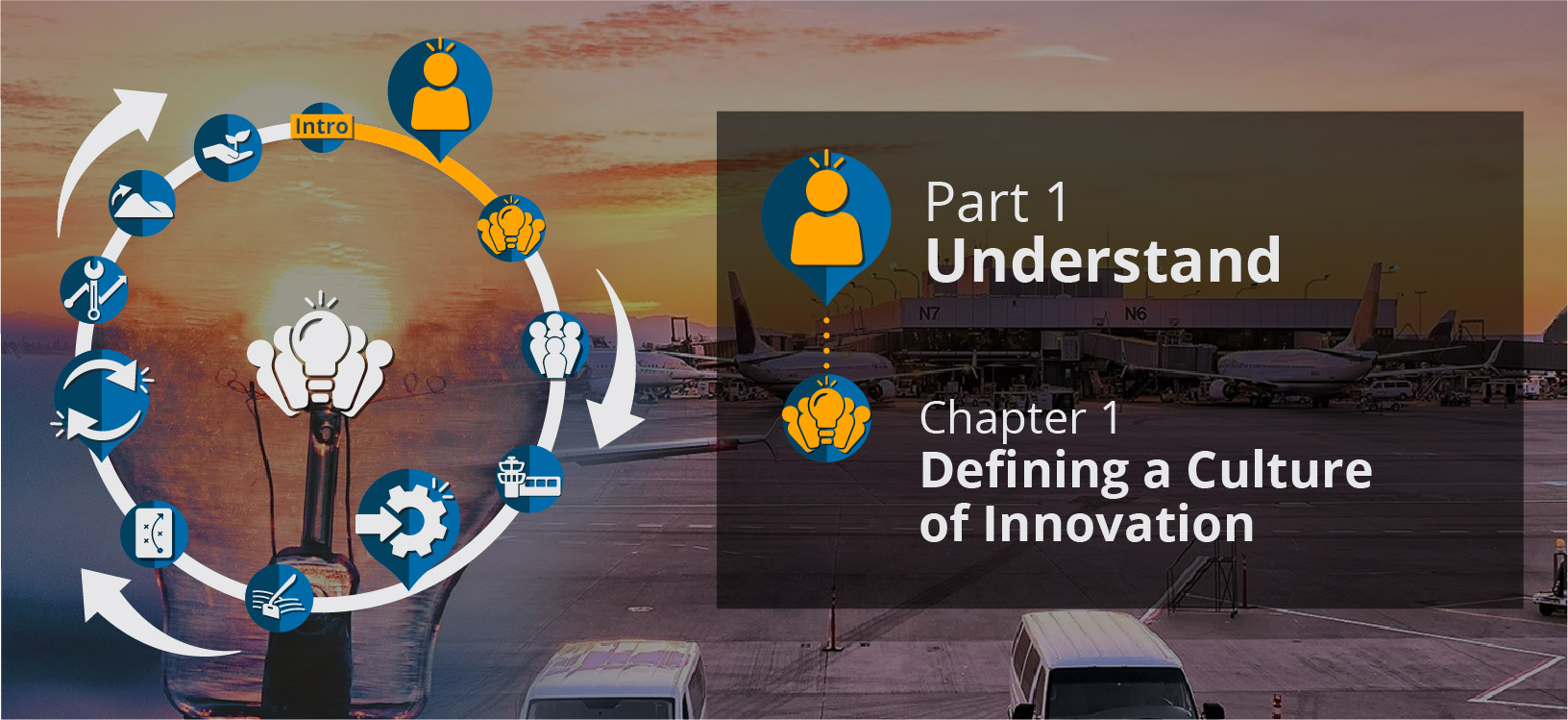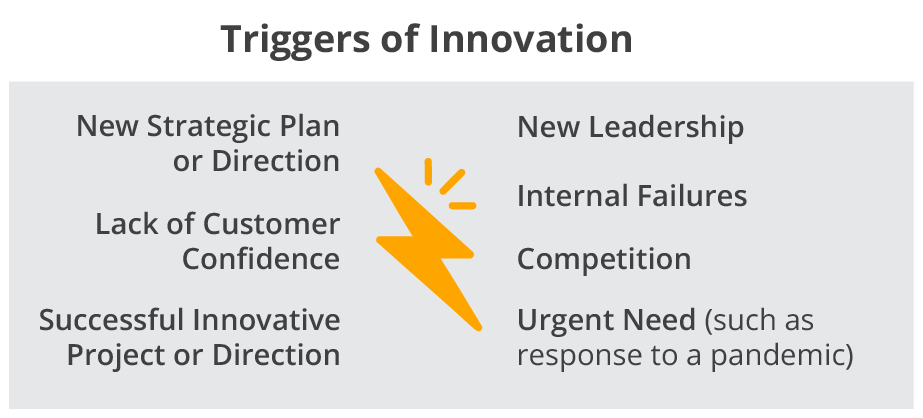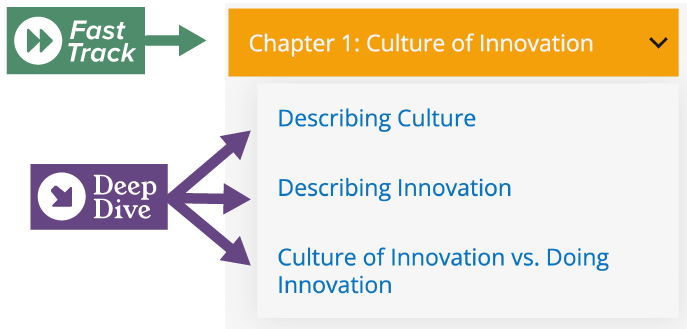

This is a Deep Dive page. Select the chapter for the Fast Track
Describing Innovation
What is Innovation?
As noted by Merriam-Webster, innovation is “a new idea, method or device: novelty” or “the introduction of something new.”1 It is the process of developing and applying ideas to improve the way things are accomplished or achieved.
Various innovation experts have defined innovation and its application to their specific business sectors. The research supporting this WebResource provides you with quick access to highlights of such findings. In an article on ideatovalue.com, innovation experts share their definitions of innovation. The following are of particular interest:2
- “The applications of ideas that are novel and useful” -David Burkus
- “Staying relevant” -Stephen Shapiro
- “The introduction of new products and services that add value to the organization” -Kevin McFarthing
- “The implementation of creative ideas in order to generate value, usually through increased revenues, reduced costs or both” -Jeffrey Baumgartner
The Invisible Advantage further defines types of innovation as the following:
- Incremental innovation, where the organization is focused on improving the core business functions every day;
- Sustaining innovation, which creates major advancements in core business functions for the benefit of existing customers and markets; and
- Disruptive innovation, where advances with new business models reinvent the organization for the longer term.3
These definitions characterize the increasing trend at many U.S. airports over the past several years to implement new solutions to improve passenger processing and facility management.
U.S. airports experienced strong growth in 2019, with many achieving double-digit passenger increases, expanding airline markets/routes, and processing more passengers than ever. To meet the challenges of this high demand, airport operators found themselves pivoting to adapt to the changing landscape and developing their people to innovate across the facility.
In 2020, U.S. airports faced unprecedented times brought on by the COVID-19 pandemic. Passenger activity declined to a record low, airline routes and markets evaporated, and airports, once bustling with passengers, sat nearly empty. To meet these unexpected challenges, airport operators had to carry out a radical shift of their people to innovate, pivot, and adapt to an entirely different and changing landscape.
Adjusting to and planning for the ever-changing airport environment is increasingly difficult for our nation's airports. Burdened with a complex set of federal regulations that strive for a safe and secure travel experience, while operating under a restrictive governance structure, airport operators face a fast-paced environment that necessitates innovation in everything they do. These challenges are not met simply by adding new technology, creating a new position title, or hiring a new human resource; rather, they are met by airport operators adopting a culture of innovation that holds to the premise: “innovation is what we do, not just something else we do.”
In response to the pandemic, many airports quickly began investigating and implementing technological innovations to address the needs for enhanced cleaning, social distancing, touchless transactions, and passenger confidence. These innovations included automated cleaning robots, self-bag drop, biometric identification, virtual queuing, and passenger tracking for congestion management in queue lines and other choke points throughout the airport. While addressing immediate concerns related to the pandemic, these solutions will have lasting operational benefits to airports; many airports would not have realized these benefits for several years to come due to the lack of a common priority between the airports, airlines, and regulatory agencies. The pandemic provided this common priority and an opportunity for these innovations to accelerate.
In addition, some airports innovated their project planning and took advantage of the low passenger counts in terminals to escalate construction projects and perform activities that would be disruptive during normal flight operations, such as major maintenance projects and technology system upgrades.
Why Innovate?
Research has revealed that there are drivers that prompt airports to consider innovating. Drivers were consistently characterized as “why we need innovation.” Figure D1.1 presents some of the major innovation drivers.

* “Customer” can refer to passengers as well as other external partners, like airlines, government agencies, concessionaires, tenants, or fixed-base operators.
Figure D1.1: Why Innovate?
When airports need to do things faster or with fewer resources, they may be driven to innovate; they may start looking to new processes, procedures, or technologies to improve their operational efficiency. Innovative solutions may be considered by airports needing to optimize their use of space, especially for those on a smaller footprint with few options for expansion. Airports are always looking for revenue-generating sources, so any new idea that can produce new revenue streams, like new technology solutions, or that can save money, like automation of maintenance tasks, can be a driver for innovation.
Airports that put the customer first in their strategies often find new ways to innovate and improve on the customer experience. For example, partnering with government agencies to provide faster and more efficient screening processes can greatly enhance the customer experience. Or, more recently, customer health and safety has been the impetus for airport innovations such as touchless technology and improved sanitation procedures. Further, concern about an airport's reputation in the industry can often prompt considerations that usually benefit passengers, such as developing a new strategy for cleaning restrooms more frequently. All of these drivers help explain why airports innovate.
Taking ownership of the customer experience is exactly what one airport did to ensure that its reputation with its customers remained positive. In this particular case, airport leadership initiated standards and protocols for all signage throughout the airport-even going so far as to have any wayfinding on the airport campus manufactured by a common vendor under contract with the airport. This ensured that passengers could locate directions easily by cuing into the colors, style, and placement of the airport's signs. Additionally, with the reputation of the airport at stake, this airport took over custodial responsibilities for the holdrooms, restrooms, and other public spaces in their airport, ensuring that the cleanliness of these spaces met airport standards.
What Starts Innovation?
Research has also revealed that various triggers can provide the spark that gets innovation going. Drivers may explain why innovation is important, but triggers are “what start innovation.” Figure D1.2 presents some of the major innovation triggers.

Figure D1.2: What Starts Innovation.
While airports have a desire to innovate, they may need an actual trigger to get things started. Most of the time, innovation begins at airports when new leadership is brought on board. This was the case at Dane County Regional Airport (MSN) when a new airport director was brought in to help transform the airport from an organization that was unforgiving and did not allow mistakes to an airport that now gives people the liberty to try new things and experiment without fear of punishment.
Another way innovation is triggered is when a leader develops a new strategic plan or takes the airport in a new direction that prioritizes new solutions. This was the case for one newly appointed airport director when faced with airline deregulation many years ago. While many saw this as a challenge to the aviation industry, this leader saw the opportunity to build a brand-new airport that could handle a lot more airlines.
When airports find themselves lacking customer confidence, they become motivated to seek solutions. For instance, when passengers express that they are afraid they will not have access to basic essentials like food and water if stranded overnight, it becomes important for the airport to ensure that customers never have that experience. When passengers at Toronto Pearson International Airport (YYZ) were stranded at the airport during a snowstorm that lasted three days, the airport hired a new leader and changed its strategic vision from operational- to business-focused to create a better passenger experience.
Competition can also trigger airports to consider new ideas. The Cincinnati/Northern Kentucky International Airport (CVG) can trace its innovation inspiration to its need to compete with five surrounding airports for passengers. As a result, this airport appointed a four-member innovation team that has been working on changing the corporate culture to become more innovative by (1) driving innovation into the airport's strategic plan and department policies, (2) partnering with the University of Miami to establish an innovation lab at Miami University Airport (OXD) in Oxford, Ohio, (3) working with start-ups to test new technologies and with government agencies to create efficiencies, (4) learning from European and peer airports, (5) developing talent for the region, and (6) keeping an eye on product improvement trends to future proof the airport.
Some other airports use a successful innovative project or direction to trigger innovation. San Diego International Airport (SAN) has benefitted from new revenue-generating possibilities, mainly due to its location in an innovative city with many start-up companies and its ability to form an innovation lab from a decommissioned terminal. This lab forms the structure for innovation and drives policies of the airport, which play out in the day-to-day actions of the airport's staff and directors.
Airports may also turn to innovation due to an urgent need that forces them to make swift changes to their current operating models. All airports around the world had to take drastic action to respond to new health guidance due to the pandemic in 2020. Louisville Muhammad Ali International Airport (SDF) needed to find a way to protect their airport ambassadors, most of whom were retirees and particularly vulnerable to the virus. The airport's vice president of legal and corporate culture suggested that they enable the ambassadors to appear “live” on computer screens at customer assistance areas in the terminal via conference-calling technology. This change enabled them to still provide a needed service to their customers, just in a new format.


1 Merriam-Webster, Inc., “Innovation,” accessed April 1, 2022, https://www.merriam-webster.com/dictionary/innovation.
2 Nick Skillicorn, “What is Innovation? 26 Experts Share Their Innovation Definition,” Ideatovalue.com, March 18, 2016, https://www.ideatovalue.com/inno/nickskillicorn/2016/03/innovation-15-experts-share-innovation-definition/.
3 Soren Kaplan, The Invisible Advantage: How to Create a Culture of Innovation (Austin, TX), 2017, https://www.sorenkaplan.com/invisibleadvantage/.

